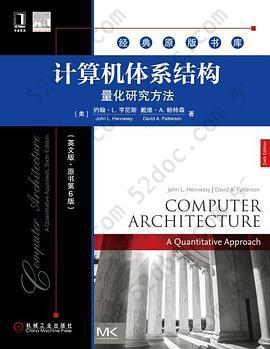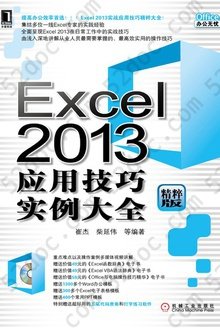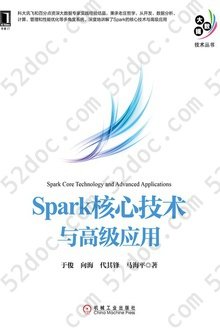注重体验与质量的电子书资源下载网站
分类于: 职场办公 设计
简介

计算机体系结构: 量化研究方法(英文版·原书第6版) 豆 0.0分
资源最后更新于 2020-08-23 16:18:11
作者:[美] 约翰·L. 亨尼斯(John L. Hennessy)
出版社:机械工业出版社
出版日期:2019-01
ISBN:9787111631101
文件格式: pdf
标签: CS 计算机 计算机体系结构 架构 计算机科学 計算機結構 美國
简介· · · · · ·
在过去20多年的时间里,本书一直是计算机领域的教师、学生和体系结构设计人员的必读之作。两位作者Hennessy和Patterson于2017年荣获图灵奖,肯定了他们对计算机领域持久而重要的技术贡献。随着处理器和系统架构的最新发展,第6版进行了全面修订。这一版采用RISC-V指令集体系结构,这是一个现代的RISC指令集,被设计为免费且可公开采用的标准。书中还增加了一个关于领域特定体系结构的新章节,并更新了关于仓储级计算的章节,其中介绍了谷歌最新的WSC。与本书之前版本的目标一样,本书致力于揭开计算机体系结构的神秘面纱,关注那些令人兴奋的技术创新,同时强调良好的工程设计。
目录
Chapter 1 Fundamentals of Quantitative Design and Analysis
1.1 Introduction 2
1.2 Classes of Computers 6
1.3 Defining Computer Architecture 11
1.4 Trends in Technology 18
1.5 Trends in Power and Energy in Integrated Circuits 23
1.6 Trends in Cost 29
1.7 Dependability 36
1.8 Measuring, Reporting, and Summarizing Performance 39
1.9 Quantitative Principles of Computer Design 48
1.10 Putting It All Together: Performance, Price, and Power 55
1.11 Fallacies and Pitfalls 58
1.12 Concluding Remarks 64
1.13 Historical Perspectives and References 67
Case Studies and Exercises by Diana Franklin 67
Chapter 2 Memory Hierarchy Design
2.1 Introduction 78
2.2 Memory Technology and Optimizations 84
2.3 Ten Advanced Optimizations of Cache Performance 94
2.4 Virtual Memory and Virtual Machines 118
2.5 Cross-Cutting Issues: The Design of Memory Hierarchies 126
2.6 Putting It All Together: Memory Hierarchies in the ARM Cortex-A53 and Intel Core i7 6700 129
2.7 Fallacies and Pitfalls 142
2.8 Concluding Remarks: Looking Ahead 146
2.9 Historical Perspectives and References 148
Case Studies and Exercises by Norman P. Jouppi, Rajeev
Balasubramonian, Naveen Muralimanohar, and Sheng Li
Chapter 3 Instruction-Level Parallelism and Its Exploitation
3.1 Instruction-Level Parallelism: Concepts and Challenges 168
3.2 Basic Compiler Techniques for Exposing ILP 176
3.3 Reducing Branch Costs With Advanced Branch Prediction 182
3.4 Overcoming Data Hazards With Dynamic Scheduling 191
3.5 Dynamic Scheduling: Examples and the Algorithm 201
3.6 Hardware-Based Speculation 208
3.7 Exploiting ILP Using Multiple Issue and Static Scheduling 218
3.8 Exploiting ILP Using Dynamic Scheduling, Multiple Issue, and Speculation 222
3.9 Advanced Techniques for Instruction Delivery and Speculation 228
3.10 Cross-Cutting Issues 240
3.11 Multithreading: Exploiting Thread-Level Parallelism to Improve Uniprocessor Throughput 242
3.12 Putting It All Together: The Intel Core i7 6700 and ARM Cortex-A53 247
3.13 Fallacies and Pitfalls 258
3.14 Concluding Remarks: What’s Ahead 264
3.15 Historical Perspective and References 266
Case Studies and Exercises by Jason D. Bakos and Robert P. Colwell 266
Chapter 4 Data-Level Parallelism in Vector, SIMD, and GPU Architectures
4.1 Introduction 282
4.2 Vector Architecture 283
4.3 SIMD Instruction Set Extensions for Multimedia 304
4.4 Graphics Processing Units 310
4.5 Detecting and Enhancing Loop-Level Parallelism 336
4.6 Cross-Cutting Issues 345
4.7 Putting It All Together: Embedded Versus Server GPUs and Tesla Versus Core i7 346
4.8 Fallacies and Pitfalls 353
4.9 Concluding Remarks 357
4.10 Historical Perspective and References 357
Case Study and Exercises by Jason D. Bakos 357
Chapter 5 Thread-Level Parallelism
5.1 Introduction 368
5.2 Centralized Shared-Memory Architectures 377
5.3 Performance of Symmetric Shared-Memory Multiprocessors 393
5.4 Distributed Shared-Memory and Directory-Based Coherence 404
5.5 Synchronization: The Basics 412
5.6 Models of Memory Consistency: An Introduction 417
5.7 Cross-Cutting Issues 422
5.8 Putting It All Together: Multicore Processors and Their Performance 426
5.9 Fallacies and Pitfalls 438
5.10 The Future of Multicore Scaling 442
5.11 Concluding Remarks 444
5.12 Historical Perspectives and References 445
Case Studies and Exercises by Amr Zaky and David A. Wood 446
Chapter 6 Warehouse-Scale Computers to Exploit Request-Level and Data-Level Parallelism
6.1 Introduction 466
6.2 Programming Models and Workloads for Warehouse-Scale Computers 471
6.3 Computer Architecture of Warehouse-Scale Computers 477
6.4 The Efficiency and Cost of Warehouse-Scale Computers 482
6.5 Cloud Computing: The Return of Utility Computing 490
6.6 Cross-Cutting Issues 501
6.7 Putting It All Together: A Google Warehouse-Scale Computer 503
6.8 Fallacies and Pitfalls 514
6.9 Concluding Remarks 518
6.10 Historical Perspectives and References 519
Case Studies and Exercises by Parthasarathy Ranganathan 519
Chapter 7 Domain-Specific Architectures
7.1 Introduction 540
7.2 Guidelines for DSAs 543
7.3 Example Domain: Deep Neural Networks 544
7.4 Google’s Tensor Processing Unit, an Inference Data Center Accelerator 557
7.5 Microsoft Catapult, a Flexible Data Center Accelerator 567
7.6 Intel Crest, a Data Center Accelerator for Training 579
7.7 Pixel Visual Core, a Personal Mobile Device Image Processing Unit 579
7.8 Cross-Cutting Issues 592
7.9 Putting It All Together: CPUs Versus GPUs Versus DNN Accelerators 595
7.10 Fallacies and Pitfalls 602
7.11 Concluding Remarks 604
7.12 Historical Perspectives and References 606
Case Studies and Exercises by Cliff Young 606
Appendix A Instruction Set Principles
A.1 Introduction A-2
A.2 Classifying Instruction Set Architectures A-3
A.3 Memory Addressing A-7
A.4 Type and Size of Operands A-13
A.5 Operations in the Instruction Set A-15
A.6 Instructions for Control Flow A-16
A.7 Encoding an Instruction Set A-21
A.8 Cross-Cutting Issues: The Role of Compilers A-24
A.9 Putting It All Together: The RISC-V Architecture A-33
A.10 Fallacies and Pitfalls A-42
A.11 Concluding Remarks A-46
A.12 Historical Perspective and References A-47
Exercises by Gregory D. Peterson A-47
Appendix B Review of Memory Hierarchy
B.1 Introduction B-2
B.2 Cache Performance B-15
B.3 Six Basic Cache Optimizations B-22
B.4 Virtual Memory B-40
B.5 Protection and Examples of Virtual Memory B-49
B.6 Fallacies and Pitfalls B-57
B.7 Concluding Remarks B-59
B.8 Historical Perspective and References B-59
Exercises by Amr Zaky B-60
Appendix C Pipelining: Basic and Intermediate Concepts
C.1 Introduction C-2
C.2 The Major Hurdle of Pipelining—Pipeline Hazards C-10
C.3 How Is Pipelining Implemented C-26
C.4 What Makes Pipelining Hard to Implement C-37
C.5 Extending the RISC V Integer Pipeline to Handle Multicycle Operations C-45
C.6 Putting It All Together: The MIPS R4000 Pipeline C-55
C.7 Cross-Cutting Issues C-65
C.8 Fallacies and Pitfalls C-70
C.9 Concluding Remarks C-71
C.10 Historical Perspective and References C-71
Updated Exercises by Diana Franklin C-71
References R-1
Index I-1
Online Appendices
Appendix D Storage Systems
Appendix E Embedded Systems
by Thomas M. Conte
Appendix F Interconnection Networks
by Timothy M. Pinkston and Jos.e Duato
Appendix G Vector Processors in More Depth
by Krste Asanovic
Appendix H Hardware and Software for VLIW and EPIC
Appendix I Large-Scale Multiprocessors and Scientific Applications
Appendix J Computer Arithmetic
by David Goldberg
Appendix K Survey of Instruction Set Architectures
Appendix L Advanced Concepts on Address Translation
by Abhishek Bhattacharjee
Appendix M Historical Perspectives and References
1.1 Introduction 2
1.2 Classes of Computers 6
1.3 Defining Computer Architecture 11
1.4 Trends in Technology 18
1.5 Trends in Power and Energy in Integrated Circuits 23
1.6 Trends in Cost 29
1.7 Dependability 36
1.8 Measuring, Reporting, and Summarizing Performance 39
1.9 Quantitative Principles of Computer Design 48
1.10 Putting It All Together: Performance, Price, and Power 55
1.11 Fallacies and Pitfalls 58
1.12 Concluding Remarks 64
1.13 Historical Perspectives and References 67
Case Studies and Exercises by Diana Franklin 67
Chapter 2 Memory Hierarchy Design
2.1 Introduction 78
2.2 Memory Technology and Optimizations 84
2.3 Ten Advanced Optimizations of Cache Performance 94
2.4 Virtual Memory and Virtual Machines 118
2.5 Cross-Cutting Issues: The Design of Memory Hierarchies 126
2.6 Putting It All Together: Memory Hierarchies in the ARM Cortex-A53 and Intel Core i7 6700 129
2.7 Fallacies and Pitfalls 142
2.8 Concluding Remarks: Looking Ahead 146
2.9 Historical Perspectives and References 148
Case Studies and Exercises by Norman P. Jouppi, Rajeev
Balasubramonian, Naveen Muralimanohar, and Sheng Li
Chapter 3 Instruction-Level Parallelism and Its Exploitation
3.1 Instruction-Level Parallelism: Concepts and Challenges 168
3.2 Basic Compiler Techniques for Exposing ILP 176
3.3 Reducing Branch Costs With Advanced Branch Prediction 182
3.4 Overcoming Data Hazards With Dynamic Scheduling 191
3.5 Dynamic Scheduling: Examples and the Algorithm 201
3.6 Hardware-Based Speculation 208
3.7 Exploiting ILP Using Multiple Issue and Static Scheduling 218
3.8 Exploiting ILP Using Dynamic Scheduling, Multiple Issue, and Speculation 222
3.9 Advanced Techniques for Instruction Delivery and Speculation 228
3.10 Cross-Cutting Issues 240
3.11 Multithreading: Exploiting Thread-Level Parallelism to Improve Uniprocessor Throughput 242
3.12 Putting It All Together: The Intel Core i7 6700 and ARM Cortex-A53 247
3.13 Fallacies and Pitfalls 258
3.14 Concluding Remarks: What’s Ahead 264
3.15 Historical Perspective and References 266
Case Studies and Exercises by Jason D. Bakos and Robert P. Colwell 266
Chapter 4 Data-Level Parallelism in Vector, SIMD, and GPU Architectures
4.1 Introduction 282
4.2 Vector Architecture 283
4.3 SIMD Instruction Set Extensions for Multimedia 304
4.4 Graphics Processing Units 310
4.5 Detecting and Enhancing Loop-Level Parallelism 336
4.6 Cross-Cutting Issues 345
4.7 Putting It All Together: Embedded Versus Server GPUs and Tesla Versus Core i7 346
4.8 Fallacies and Pitfalls 353
4.9 Concluding Remarks 357
4.10 Historical Perspective and References 357
Case Study and Exercises by Jason D. Bakos 357
Chapter 5 Thread-Level Parallelism
5.1 Introduction 368
5.2 Centralized Shared-Memory Architectures 377
5.3 Performance of Symmetric Shared-Memory Multiprocessors 393
5.4 Distributed Shared-Memory and Directory-Based Coherence 404
5.5 Synchronization: The Basics 412
5.6 Models of Memory Consistency: An Introduction 417
5.7 Cross-Cutting Issues 422
5.8 Putting It All Together: Multicore Processors and Their Performance 426
5.9 Fallacies and Pitfalls 438
5.10 The Future of Multicore Scaling 442
5.11 Concluding Remarks 444
5.12 Historical Perspectives and References 445
Case Studies and Exercises by Amr Zaky and David A. Wood 446
Chapter 6 Warehouse-Scale Computers to Exploit Request-Level and Data-Level Parallelism
6.1 Introduction 466
6.2 Programming Models and Workloads for Warehouse-Scale Computers 471
6.3 Computer Architecture of Warehouse-Scale Computers 477
6.4 The Efficiency and Cost of Warehouse-Scale Computers 482
6.5 Cloud Computing: The Return of Utility Computing 490
6.6 Cross-Cutting Issues 501
6.7 Putting It All Together: A Google Warehouse-Scale Computer 503
6.8 Fallacies and Pitfalls 514
6.9 Concluding Remarks 518
6.10 Historical Perspectives and References 519
Case Studies and Exercises by Parthasarathy Ranganathan 519
Chapter 7 Domain-Specific Architectures
7.1 Introduction 540
7.2 Guidelines for DSAs 543
7.3 Example Domain: Deep Neural Networks 544
7.4 Google’s Tensor Processing Unit, an Inference Data Center Accelerator 557
7.5 Microsoft Catapult, a Flexible Data Center Accelerator 567
7.6 Intel Crest, a Data Center Accelerator for Training 579
7.7 Pixel Visual Core, a Personal Mobile Device Image Processing Unit 579
7.8 Cross-Cutting Issues 592
7.9 Putting It All Together: CPUs Versus GPUs Versus DNN Accelerators 595
7.10 Fallacies and Pitfalls 602
7.11 Concluding Remarks 604
7.12 Historical Perspectives and References 606
Case Studies and Exercises by Cliff Young 606
Appendix A Instruction Set Principles
A.1 Introduction A-2
A.2 Classifying Instruction Set Architectures A-3
A.3 Memory Addressing A-7
A.4 Type and Size of Operands A-13
A.5 Operations in the Instruction Set A-15
A.6 Instructions for Control Flow A-16
A.7 Encoding an Instruction Set A-21
A.8 Cross-Cutting Issues: The Role of Compilers A-24
A.9 Putting It All Together: The RISC-V Architecture A-33
A.10 Fallacies and Pitfalls A-42
A.11 Concluding Remarks A-46
A.12 Historical Perspective and References A-47
Exercises by Gregory D. Peterson A-47
Appendix B Review of Memory Hierarchy
B.1 Introduction B-2
B.2 Cache Performance B-15
B.3 Six Basic Cache Optimizations B-22
B.4 Virtual Memory B-40
B.5 Protection and Examples of Virtual Memory B-49
B.6 Fallacies and Pitfalls B-57
B.7 Concluding Remarks B-59
B.8 Historical Perspective and References B-59
Exercises by Amr Zaky B-60
Appendix C Pipelining: Basic and Intermediate Concepts
C.1 Introduction C-2
C.2 The Major Hurdle of Pipelining—Pipeline Hazards C-10
C.3 How Is Pipelining Implemented C-26
C.4 What Makes Pipelining Hard to Implement C-37
C.5 Extending the RISC V Integer Pipeline to Handle Multicycle Operations C-45
C.6 Putting It All Together: The MIPS R4000 Pipeline C-55
C.7 Cross-Cutting Issues C-65
C.8 Fallacies and Pitfalls C-70
C.9 Concluding Remarks C-71
C.10 Historical Perspective and References C-71
Updated Exercises by Diana Franklin C-71
References R-1
Index I-1
Online Appendices
Appendix D Storage Systems
Appendix E Embedded Systems
by Thomas M. Conte
Appendix F Interconnection Networks
by Timothy M. Pinkston and Jos.e Duato
Appendix G Vector Processors in More Depth
by Krste Asanovic
Appendix H Hardware and Software for VLIW and EPIC
Appendix I Large-Scale Multiprocessors and Scientific Applications
Appendix J Computer Arithmetic
by David Goldberg
Appendix K Survey of Instruction Set Architectures
Appendix L Advanced Concepts on Address Translation
by Abhishek Bhattacharjee
Appendix M Historical Perspectives and References








